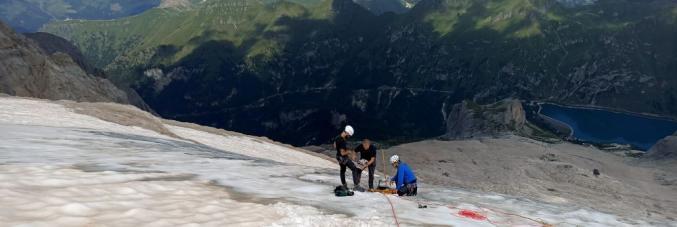
A scientific investigation clarifies the causes of the Marmolada Glacier collapse
02.07.2025
Three years after the dramatic collapse of the Marmolada Glacier, a new scientific study published in "Natural Hazards and Earth System Sciences" reveals the complex mechanisms behind the disaster. On July 3, 2022, over 70,000 cubic meters of ice suddenly detached at an altitude of 3,200 meters, sweeping away climbers on the normal route to Punta Penìa. The incident resulted in 11 deaths and at least 7 serious injuries.
The new scientific article, titled "Failure of Marmolada Glacier (Dolomites, Italy) in 2022: Data-based back analysis of possible collapse mechanisms," is the result of research conducted by an international multidisciplinary team of experts including glaciologists, geologists, engineers, and geophysicists from various Italian and European institutions: University of Parma, University of Padua, National Institute of Oceanography and Experimental Geophysics (OGS), University of Trieste, University of Zurich, ARPAV, and Stellenbosch University.
The first author, Roberto Francese from the University of Parma, explains that the research combined historical data, precise surveys, and physical-mathematical models to determine whether the glacier's instability was predictable.
The collapse occurred in a fragile sector of the glacier below Punta Rocca, with the ice detaching along a sloped area up to 40°, traveling over 2.3 km at a speed of 80-90 km/h. The research ruled out the hypothesis of an earthquake, instead identifying a combination of factors that led to the collapse: record temperatures accelerating melting, water trapped in crevasses creating high hydraulic pressures, degraded permafrost, and an unfavourable bedrock geometry.
«The glacier suddenly found itself in a precarious state of equilibrium: the internal temperature was high, the base was unstable, and the pressurised water in the crevasses and at the base exerted a force». The event occurred in a matter of seconds, but its conditions had been building up over the preceding months and years, explains Aldino Bondesan, associate professor of Physical Geography and Geomorphology at the University of Padua and corresponding author of the study.
The researchers employed advanced geophysical techniques, georadar surveys, geolectrical measurements, and LIDAR drones, along with high-resolution satellite images to analyze the presence of water. Core drilling of the glacier and temperature sensors revealed thermal conditions close to the melting point. Numerical simulation of the glacier's stability showed that only the interaction of multiple factors led to a "safety factor" below 1, indicating a loss of equilibrium.
This study provides an important interpretative key for understanding the collapse and setting up monitoring and risk prevention strategies in high mountain areas. It highlights the importance of integrating climatic observations, geophysical surveys, and numerical modeling to anticipate potentially catastrophic collapse scenarios, in the context of rapid glacier retreat and permafrost degradation in alpine and Andean regions.
The University of Padua, with a strong tradition of mountain research and recognising the growing importance of this environment in the national debate on sustainability, regeneration, and climate change, has also recently launched "Orizzonte Montagna", a project aimed at developing and enhancing educational and cultural activities related to the mountains. This initiative seeks to provide interdisciplinary training on crucial topics such as biodiversity, tourism, health, climate adaptation, and technology, addressing the concrete needs of the territory.



